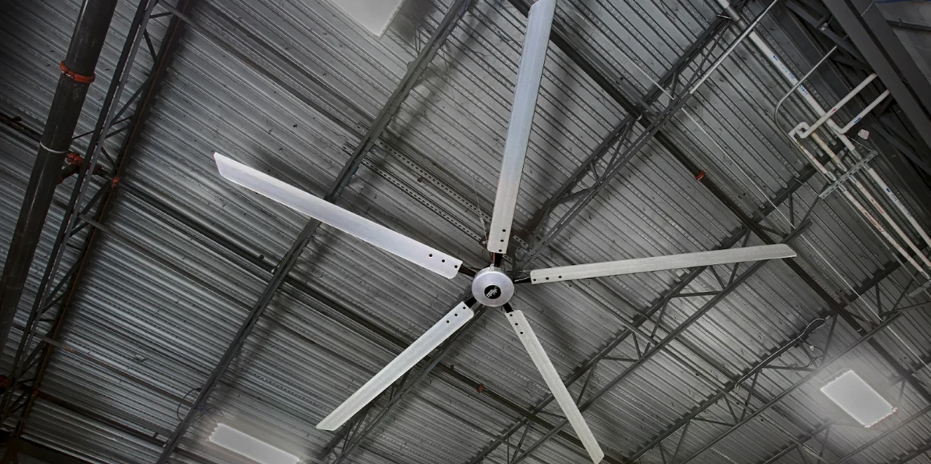
HVLS Fans Explained: Big Power, Big Efficiency
Have you ever walked into a warehouse, gym, or large retail space and noticed those giant, slow-moving fans on the ceiling? You may have wondered, “What are those big fans called?” Well, the answer is simple. They’re called HVLS fans, and they’re not just oversized ceiling fans – they’re game-changers for air circulation.
In this guide, we’ll dive into what HVLS fans are, how they work, where you can find them, and why they’re an essential addition to many industries. Let’s get started!
What Are HVLS Fans?

Looking for an HVLS fan definition? Are you curious, “What does HVLS stand for?” HVLS stands for “High-Volume, Low-Speed.” These fans are designed to move large amounts of air slowly, creating a gentle breeze across a wide area. Unlike traditional fans, which rely on speed to cool, HVLS fans work by distributing air more evenly, making them more efficient at cooling large spaces.
They’re also typically much bigger than standard ceiling fans, with some reaching up to 24 feet in diameter. This size, combined with their design, allows them to create a consistent airflow that can make any environment feel cooler, no matter the temperatures outside.
Another key difference is in efficiency. Where traditional fans might use a lot of energy to cover smaller areas, HVLS fans can move more air while using less power. That’s why they’re the go-to choice for many commercial and industrial spaces.
How Do HVLS Fans Work?
The magic of HVLS fans lies in their design. They have larger blades, which rotate at a slower speed. Instead of pushing air quickly in one direction, they create a slow-moving but powerful airflow that reaches all corners of the room. This circulation helps to reduce temperature fluctuations, creating a more balanced temperature throughout the space.
Since they don’t rely on high speeds, HVLS fans are also quieter than typical ceiling or industrial fans. This makes them perfect for settings where noise can be a distraction, like offices, warehouses, educational facilities, and gyms.
Why Use HVLS Fans?
There are plenty of reasons to consider HVLS fans for your business or facility, including:
- Energy Costs: HVLS fans can significantly cut down on energy costs. By moving air efficiently, these fans reduce the need for air conditioning, which can be a major expense in larger spaces.
- Temperature Control: Improved air circulation also means better temperature control, reducing hot and cold spots across your environment.
- Safety and Comfort: In places like warehouses and factories, heat stress can be a real issue. HVLS fans help reduce this by maintaining a cooler and more comfortable atmosphere. This is why you’ll also find them in spaces like gyms and retail stores, where comfort is super important.
When and Where Are HVLS Fans Used?
You’ll find HVLS fans and other big fans in a variety of settings, ranging from industrial to commercial and even agricultural spaces. They’re incredibly versatile, which is why they’re used across many industries.
In manufacturing and warehouses, HVLS fans keep air moving across large, open spaces, preventing stagnant air and reducing humidity. In gyms and fitness centers, they help maintain a cool environment without blasting customers with direct, high-speed air. And for agricultural settings, they can improve air quality and help with temperature control, which is essential for livestock health.
But it doesn’t stop there. Retail stores, educational facilities, healthcare environments – there’s almost no limit to where you can use an HVLS fan. They can even be used outdoors in covered spaces like pavilions and stadiums to keep air flowing on hot days.
Key Things to Consider When Choosing an HVLS Fan
Not all HVLS fans are created equal, so it’s important to know what to look for when making a purchase. From size and placement to energy efficiency and maintenance, here’s a breakdown of the most important factors you should consider when purchasing an HVLS fan.
- Size and Placement: Make sure you choose the right size fan for your space. Larger spaces typically need larger fans, but fan placement is also super important.
- Noise Levels: While HVLS fans are generally quiet, some models are quieter than others. If you’re installing one in a setting where noise matters, like an office or gym, it’s worth looking into models designed for silent operation.
- Energy Efficiency: One of the main benefits of HVLS fans is energy efficiency. Look for models that are optimized for low energy consumption without sacrificing performance.
- Cost Savings: A more energy-efficient fan might be a larger investment at first, but it could lead to higher savings in the long run.
- Control Features: You can choose from manual controls or automated systems that adjust fan speed based on the room’s temperature. Automated systems are especially helpful for maintaining a consistent environment without constant adjustments.
- Maintenance Requirements: Regular maintenance ensures your HVLS fan operates efficiently for years to come. Some models are easier to maintain than others, so keep this in mind when making your purchase.
Looking for State-of-the-Art HVLS Fans?

